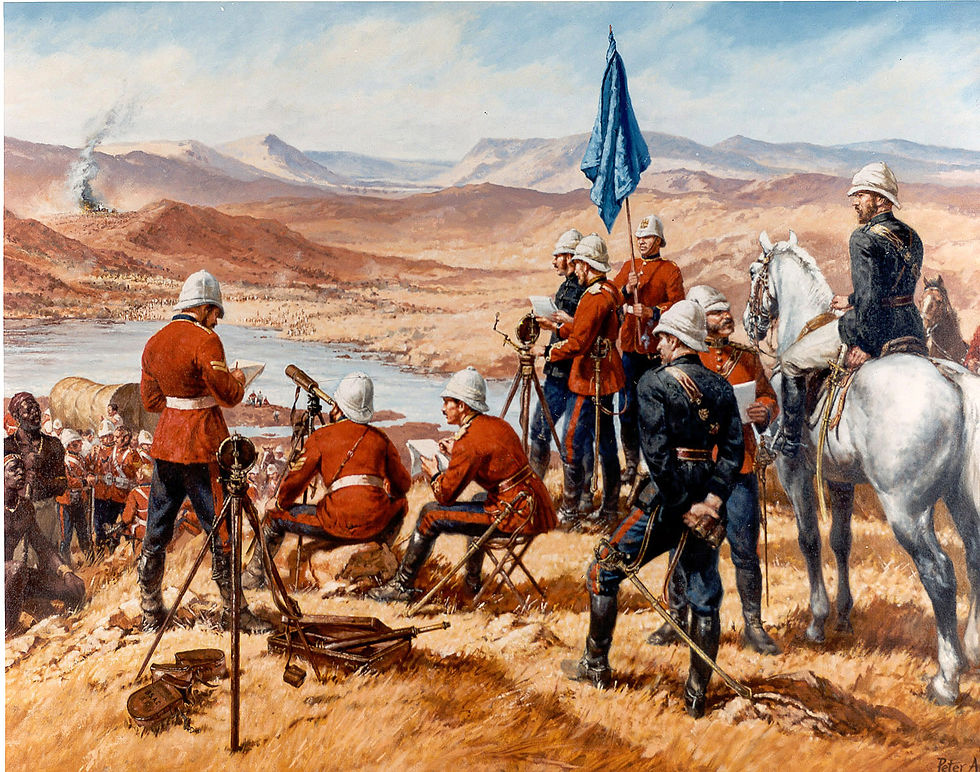The History of the Royal Corps of Signals Depicted in its Paintings
- journal86
- May 30
- 3 min read
Updated: Jul 23

This painting, Tugela River by Peter Archer, depicts the incident in March 1879 during the Zulu War when Royal Engineers signallers established contact with the beleaguered force in Fort Ekowe using heliographs.
On its formation the Royal Signals inherited from its parent unit, the Royal Engineer Signal Service, four major works of art, Through by F P Martin, and three paintings by Gilbert Holiday, which depicted the work of signallers during the First World War. In the next fifty years the Corps added portraits of its first Colonel Commandant, Lieutenant General Sir John Fowler and of its first Colonel in Chief, HRH The Princess Royal, Princess Mary.
In 1961, the Corps Committee decided to commission a series of paintings to commemorate the work of the Corps in the Second World War. This was the first of several commissions which have sought to depict the achievements of the Corps throughout its history.
To refresh the Corps corporate memory and to reintroduce the paintings, the collection will be serialised within the Journal’s History Section. There is no better place to start than with C Telegraph Troop, Royal Engineers.
In 1870 C Telegraph Troop RE was formed under the command of Captain Montague Lambert RE, with the responsibility for providing telegraph communications for the field army. At the same time the Government decided that it would purchase the private telegraph companies in the United Kingdom because they had proved to be inefficient. The GPO Telegraph thus came into existence, but it was grossly short of personnel, and it was suggested that the Royal Engineers could assist and gain valuable experience at the same time. This suggestion was accepted by the Chief Engineer and the 22nd Company RE was also made available for service with the Postal Telegraphs.
In 1872 C Telegraph Troop was involved in an army exercise which was set in Southern England and the troop set up its Headquarter in the Blandford area. Meanwhile the Postal Telegraph Companies gained their first war service experience in 1873 when a detachment took part in the expedition led by Sir Garnet Wolseley into Ashanti to deal with King Coffee Kalkaki, a noted slave trader.
C Telegraph Troop saw active service in the Zulu War of 1879 under the command of Major A C Hamilton, later Lord Belhaven and Stenton, when seven officers, 200 men and 110 horses moved from the United Kingdom to Africa to provide communications for the campaign. It was during their service in Zululand that the troops were first issued with four heliographs which had been manufactured by the Bengal Sapper and Miners in their workshop in Roorkee, India. During the campaign part of the British force became beleaguered at Fort Ekowe, with the ground between the Fort and the Tugela River being held by the Zulu army. At Tugela, Lieutenant Haynes RE spent a week heliographing in the direction of the Fort. He eventually received an answer from the Fort due to the perseverance of Major ET Wynne RE, who had noticed signal almost immediately. He first attempted to return the signal by use of shaving mirrors but, on finding that this did not work spent a week constructing a large screen which pivoted from the horizontal to the vertical thus producing the elements of morse code. As a result of this communication the Fort was relieved. Major Wynne was ill at the outset of this operation and after a week of continual exhausting work he became fatally ill and died a month later.
In 1875 Alexander Graham Bell announced his invention of the telephone and the officers of C Telegraph Troop RE decided to bring into service their own versions. Lieutenant A H Bagnold described this telephone in the Royal Engineer Journal in 1877, and in the same year Lieutenant G R R Savage, the inspector of Signalling at Roorkee, India assisted by Sergeant Martin and the sepoy artisans, began making telephones in the regimental workshops. At the end of that year the “Savage” telephones were in use on active service on the North West Frontier during the Jowaki operations. This was the first recorded use of the telephones in the war in the British and Indian armies.




Comments